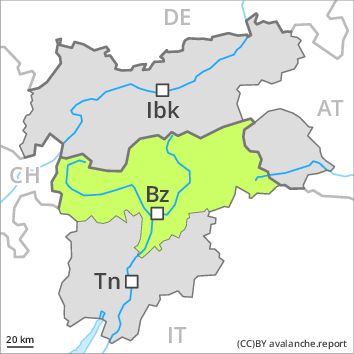Regions
Sexten Dolomites, Eastern Pfunderer Mountains, Durreck Range, Val Müstair Alps, Western Rieserferner Mountains, Langtaufers, Western Deferegger Alps, Schnals Ridge, Ortler Range, Southern Stubai Alps, Ulten Valley, Southern Zillertal Alps and High Tauern, Eastern Nonsberger Alps, Saldurn-Mastaun Ridge, Northern Dolomites of Fiemme, Texel Mountains, Gröden Dolomites, Sarntal Alps, Prags Dolomites, Western Pfunderer Mountains

Danger level
Avalanche Problem
Wind-drifted snow above the treeline, N-NE-E-SE-S-NW

Fresh wind slabs require caution.
The fresh wind slabs must be evaluated with care and prudence in particular on northwest to north to south facing aspects, in particular adjacent to ridgelines. Skiers can release avalanches in some places. Avalanches are rather small. Apart from the danger of being buried, restraint should be exercised as well in view of the danger of avalanches sweeping people along and giving rise to falls. In addition a latent danger of gliding avalanches exists, in particular in case of releases originating from south facing starting zones below approximately 2600 m that have retained the snow thus far.
Snowpack
dp 6: cold, loose snow and wind
The fresh wind slabs remain in some cases prone to triggering. This applies at high altitudes and in high Alpine regions. The old snowpack will be generally well bonded. The surface of the snowpack is frozen, but not to a significant depth. This applies in particular on steep sunny slopes below approximately 2600 m.
Tendency
Strong northwesterly wind. The avalanche danger will persist.